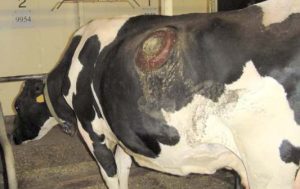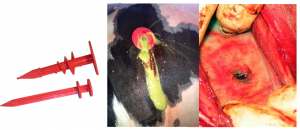FA GI Topics
Forestomach disorders and surgery
Bovine forestomach disorders include free gas bloat, frothy bloat, hardware disease, rumenitis/rumen acidosis, vagal indigestion, foreign bodies, grain overload/toxin ingestion, and omasal impaction. For the forestomachs, only rumen surgery is common.
Rumenotomies and rumenostomies
Surgery can be useful for bloat, hardware disease, foreign bodies, and grain overload/toxin ingestion. In cases of vagal indigestion, surgery can be useful to verify that there is nothing treatable and that the best option is to cull the animal.
‘Otomy’ refers to a temporary hole while an ‘ostomy’ is a permanent opening. In cattle, most all holes eventually close, so an ‘ostomy’ is open for awhile but not usually permanently. [“ectomy” refers to cutting something off]
Rumenotomy is indicated for vagal indigestion, hardware disease, rumen acidosis and some forms of choke. Rumenotomy allows exploration of the rumen, reticulum and parts of the omasum.
Rumenostomy is performed in growing calves with chronic bloat (see below) and in any age ruminant to provide nutritional support. Rumenostomies can be performed instead of rumen trocarization for improved results. Rumenostomies are also performed for feed trials to enable direct feeding and/or sampling. Finally, a rumenostomy can be placed in an adult cow to provide easy access to microflora (rumen donor). Rumenostomies typically have smaller openings designed to close over time (calves) or are kept open with a rumen cannula sized to fit the cow and the need (feeding, fauna donor).

Bloat
Free gas bloat occurs with insufficient eructation (burping). Free gas bloat can occur with high levels of gas production, esophageal obstruction, or motility dysfunction. Gas production is increased with dietary changes and excessive fermentable feedstuffs. Blockage of eructation by an esophageal obstruction or lack of proper nerve function can be rapidly fatal in cattle due to pressure on the diaphragm.
A stomach tube can be placed into the rumen via the esophagus to remove the gas safely. Alternately, a red rumen trocar can be inserted into the rumen via a skin incision in the flank. The trocar will lead to rumen fluid leakage and some level of peritonitis.

Frothy bloat most commonly occurs due to ingestion of legumes (alfalfa, beans). Stomach tubing will not relieve a frothy bloat. The animal should be treated with a product designed to destabilize the froth (eg poloxalene).
Bloat is diagnosed by an “apple” appearance on the left side and a “pear” appearance on the right due to the distension of both the dorsal and ventral sacs of the rumen.

A ping will be present on the left, including with percussion on the transverse processes of the vertebrae. The balloon-like distension can be palpated per rectum. Cattle may show signs of dyspnea due to pressure on the diaphragm. Death may occur if the bloat is not treated.
Calves often develop recurrent bloat as they adjust to a more adult diet. It can take awhile for the rumen flora to adjust. A rumenostomy can be performed to allow gas to escape as needed until the problem resolves. These will close over eventually.
Grain overload/toxins
Rumenotomy can also be useful to remove the grain or toxins if the ingestion is identified early enough. As most of the ingest needs to be removed in these cases, transfaunation (providing rumen juice from a healthy cow) is recommended to help rebalance the flora.
Omasal impactions
Omasal impactions rarely need direct treatment and are usually secondary to another issue. Treat the inciting cause and rehydrate the animal.
Resources
Microbial production of gas (physiology review)
remove from the herd, usually by shipping to slaughter but animals could be euthanized or slaughtered on the farm.
traumatic reticuloperitonitis; foreign objects poke through the reticulum

